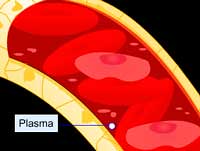
Blood transfusions often cause complications that cost the American healthcare system—to the tune of $17 billion dollars in total since they started being used, according to the UC San Diego Technology Transfer Office.
Researchers there have shown that expanding the viscosity of blood plasma increases pressure on blood vessel walls and leads the body to produce more nitric oxide (NO). More NO improves production and distribution of oxygen as well as allowing tissues to consume less oxygen. The whole package may obviate some of the difficulties of blood transfusions and even “lessen the need of a transfusion until blood losses lower the red blood cell concentration to one-quarter of normal, reducing hematocrit to approximately 12%.”
“Examples of NO producing plasma expanders include polyethylene glycol (PEG), PEG-albumin (human serum albumin), PEG-hemoglobulin, and long polymers such as dextran, poly-lactic acid, starch.”
These expanders all sound like well-understood products. So score one for UC San Diego for discovering a gentler , less invasive way to help victims who need acute treatment for fluid and/or blood loss due to hypovolemia, anemia, hemorrhagic shock, surgical procedures, low flow rates, and other conditions.
, less invasive way to help victims who need acute treatment for fluid and/or blood loss due to hypovolemia, anemia, hemorrhagic shock, surgical procedures, low flow rates, and other conditions.